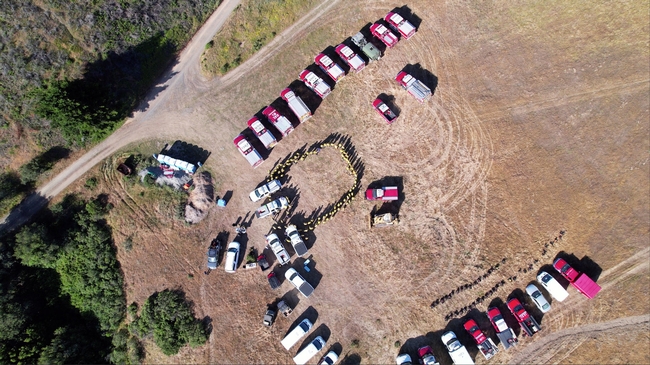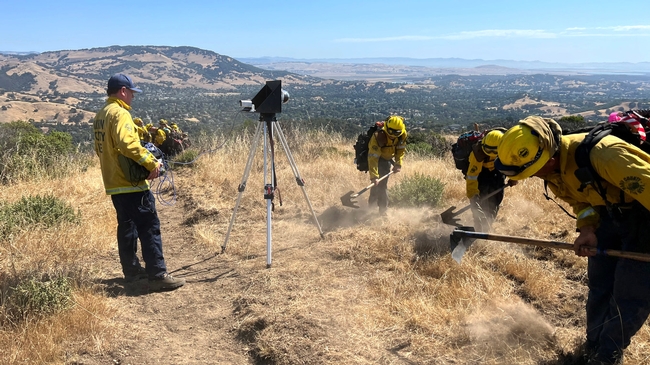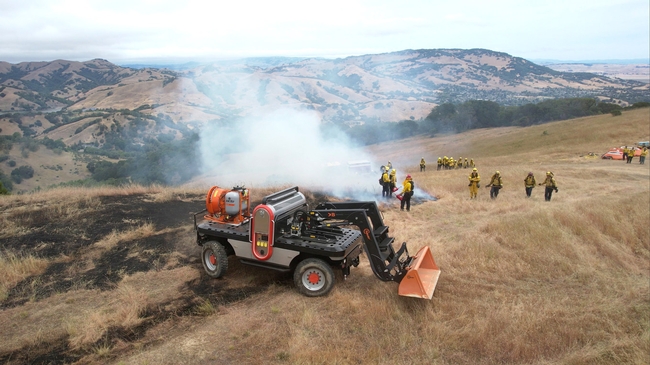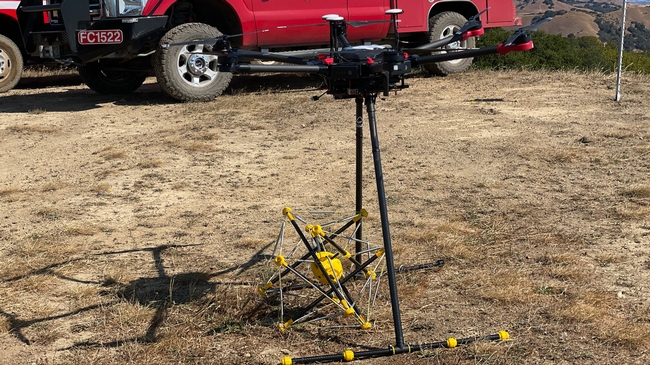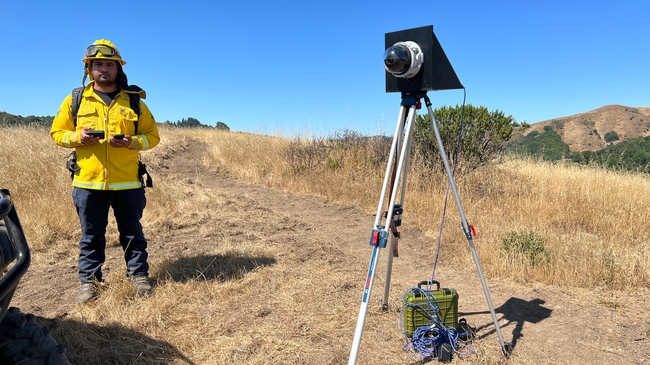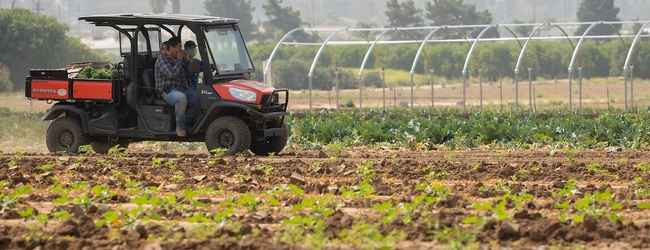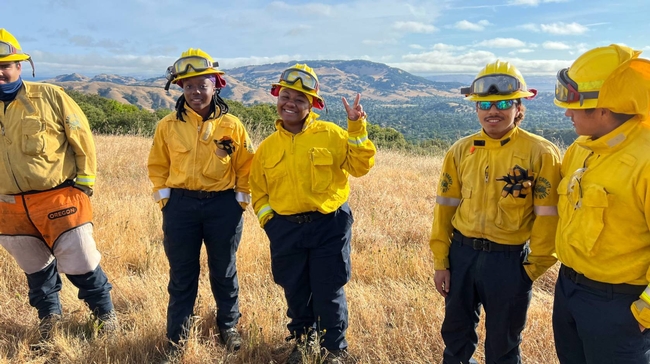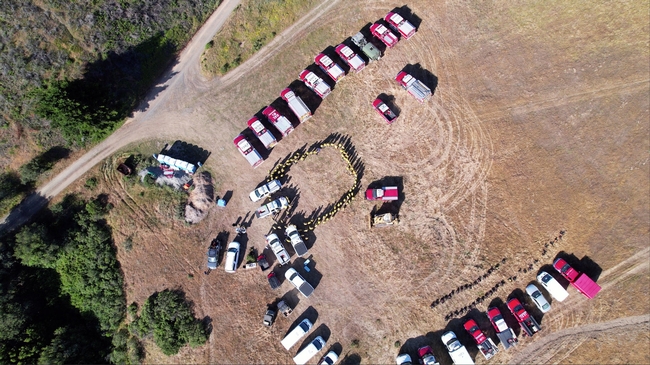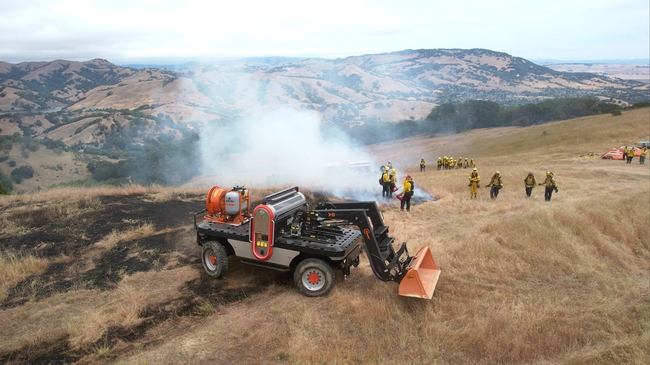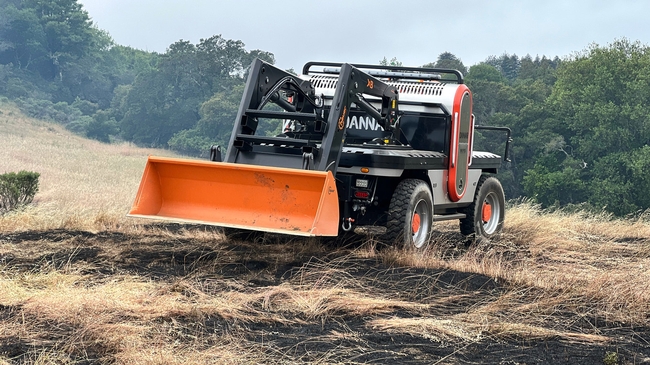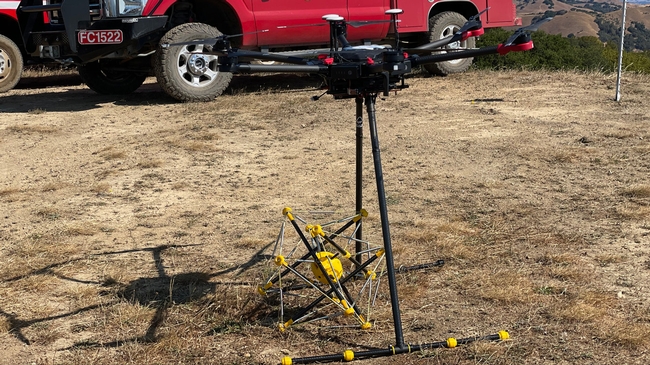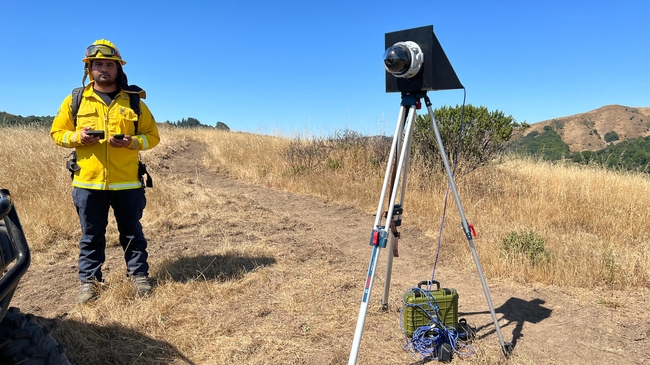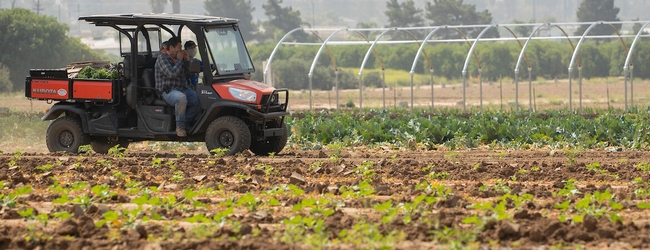- Author: Marni Ellery, INGENIERÍA DE UC Berkeley

Este verano marca los primeros ejercicios reales de entrenamiento de fuego para el grupo inaugural de reclutas de FIRE Foundry. A través del Laboratorio de Desastres de UC Berkeley, estos bomberos en entrenamiento han participado en una quema controlada de aproximadamente 300 acres sobre la ciudad de Novato, California, mientras trabajan junto a ingenieros de Berkeley probando generadores de energía móviles, vehículos eléctricos de emergencia y prevención de incendios, sistemas de detección de incendios forestales de inteligencia artificial y otras herramientas innovadoras.
"FIRE Foundry es único porque tiene como objetivo eliminar tanto las barreras que impiden que los grupos subrepresentados sigan carreras en el servicio de bomberos como las barreras que impiden la adopción de tecnología en ese campo", dijo Thomas Azwell, quien dirige Disaster Lab, el programa multifacético de UC Berkeley Engineering que trabaja para desarrollar e implementar soluciones de ingeniería innovadoras para los desafíos ambientales. "Esperamos que pueda servir como modelo para futuros programas de reclutamiento y capacitación".
Rompiendo las barreras
FIRE Foundry es una colaboración multiorganizacional dirigida por el Departamento de Bomberos del Condado de Marin en asociación con UC Berkeley, la Oficina de Equidad del Condado de Marin, varias otras agencias de bomberos de Marin, el Colegio de Marin y el Cuerpo de Conservación.
Hace dos años, el jefe de bomberos del Departamento de Bomberos del Condado de Marin, Jason Weber, se acercó a Azwell para crear un programa de desarrollo para aumentar la diversidad en el servicio de bomberos, específicamente reclutando a más personas de color y mujeres. Azwell estaba a bordo para crear una asociación que se basaría en los muchos recursos de Laboratorio de Desastres o Disaster Lab. Por su nombre en inglés.
Un científico ambiental con experiencia en respuesta a desastres, Azwell había cambiado recientemente su enfoque de los proyectos de remediación en el extranjero al creciente flagelo de los incendios forestales en California. Creía que las comunidades se beneficiarían de equipos de bomberos más diversos, y vio la oportunidad de educar a esta próxima generación de bomberos sobre nuevas tecnologías para combatir los incendios forestales.
Inicialmente, Weber y Azwell identificaron la falta de alcance y los obstáculos financieros como las razones por las que había tan pocos solicitantes de bomberos de comunidades tradicionalmente subrepresentadas. Ellos decidieron expandir el equipo de desarrollo del programa para aportar experiencia adicional en diseño de programas centrados en la equidad y educación tecnológica.
Sukh Singh, gerente de Disaster Lab; Joshua Dimon, académico visitante de Disaster Lab; y Sofía Martínez, analista de capital de la Oficina de Equidad del Condado de Marin, comenzaron a desarrollar el diseño de FIRE Foundry con Azwell y Weber. Juntos, aprendieron que, para revertir el bajo número de mujeres y personas de color en el servicio de bomberos, necesitarían un enfoque más holístico para la divulgación. Esto incluyó identificar caminos claros hacia el servicio de bomberos, desarrollar un sentido de pertenencia a través del aprendizaje y la tutoría, y proporcionar asesoramiento educativo para aquellos de comunidades desatendidas por sistemas escolares de calidad.
FIRE Foundry tenía como objetivo satisfacer esas necesidades, comenzando con su primera cohorte. De esos 19 reclutas, la mayoría se identifican como latinos y afroamericanos, y ocho reclutas se identifican como mujeres o no binarios.
"Creamos un programa que proporciona los servicios integrales, desde apoyo financiero hasta tutoría, para apoyar a los reclutas a través de la pieza educativa, su certificación de Técnico en Emergencias Médicas [EMT] y la Academia de Bomberos 1", dijo Azwell. "Queremos que tengan lo que necesitan no solo para estar calificados, sino para ser los candidatos más excepcionales que solicitan carreras en el servicio de bomberos".
El apoyo comienza temprano cuando los reclutas tienen tan solo 18 años de edad. Comienza con los cursos, ofrecidos en colaboración con el Colegio de Marín, y continúa a través de los rigores de la academia de extinción de incendios.
Después de un año en el programa FIRE Foundry, los participantes habrán obtenido certificados de Respondedor Médico de Emergencia (EMR) y EMT, y habrán terminado los cursos de prerrequisitos requeridos sobre operaciones introductorias de incendios y ciencia, además de incendios forestales y habilidades emergentes de ciencia y tecnología de incendios.
El programa continúa brindando apoyo a los candidatos a medida que avanzan a través de la academia de bomberos y preparando a los graduados de la academia para entrevistas de trabajo. Después de que los graduados son contratados y trabajan durante un año más o menos, los gerentes del programa les pedirán que regresen como mentores para futuros reclutas en el programa.
Según Weber, la asociación con Berkeley es una parte integral de la experiencia. "Creo que la importancia de la educación secundaria y tener una institución como Berkeley que tiene una reputación tan maravillosa por sí sola aporta valor al programa", dijo.
Capacitación sobre tecnologías emergentes de extinción de incendios
Azwell también trabaja con colegas para integrar las tecnologías de detección y respuesta a incendios que se están desarrollando a través de Disaster Lab en el programa de capacitación FIRE Foundry. Debido a que Disaster Lab reúne recursos de investigación de una gran cantidad de agencias y organizaciones, incluidos los laboratorios de UC Berkeley, las nuevas empresas de tecnología contra incendios, las agencias de bomberos, el Departamento de Defensa y múltiples ramas del ejército, los reclutas conocen algunas de las últimas herramientas y métodos que se están desarrollando para combatir incendios.
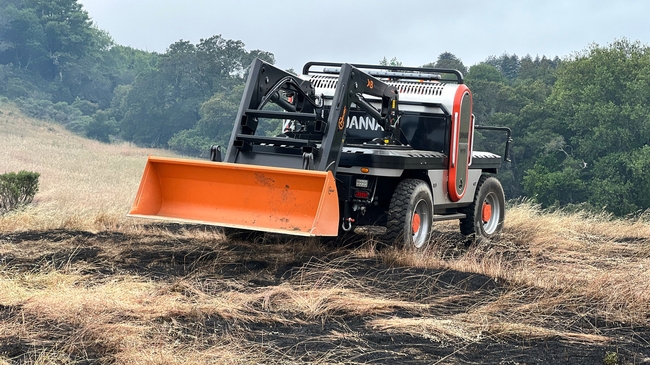
Weber cree que traer tecnología emergente al servicio de bomberos, especialmente para aquellos que recién comienzan su carrera, es una pieza crítica del programa. "Les permitirá no solo probar la tecnología que está surgiendo, sino que para esta próxima generación, que es mucho más conocedora de la tecnología que todos los bomberos existentes, les dará la oportunidad de usar y adoptar tecnologías nuevas y emergentes en las ciencias del fuego", dijo.
La Academia Wildland, un programa que se ejecuta a través de Disaster Lab, brinda a los reclutas de FIRE Foundry acceso a oportunidades críticas de aprendizaje experiencial, desde la realización de quemas controladas hasta la prueba de campo de tecnologías innovadoras desarrolladas por ingenieros de UC Berkeley y organizaciones asociadas.
Muchas de estas tecnologías fueron desarrolladas por “startups” incubadas a través de CITRIS Foundry y el Sutardja Center for Entrepreneurship & Technology. Algunos se originaron con los cursos de Challenge Lab, que se centran en las brechas en la innovación y las ideas para satisfacer esas necesidades, impartidos por Azwell en Disaster Lab.
Una de las tecnologías que se están probando en la Academia Wildland es un sensor diseñado por Squishy Robotics, una compañía derivada de la investigación que comenzó en Berkeley. Su cofundadora, Alice Agogino, profesora de ingeniería mecánica, y su equipo han creado un paquete de sensores rodeado de un exoesqueleto resistente pero flexible que se puede utilizar para recopilar datos en diversas situaciones de desastre. Los bomberos, por ejemplo, pueden lanzar este sensor cerca de un incendio para monitorear datos térmicos, así como toxicidad, humo, calor y otras métricas valiosas. Los reclutas de FIRE Foundry tendrán la oportunidad de interactuar con Squishy Robotics en la próxima Wildland Academy y proporcionar sus comentarios sobre estos sensores.
"Tener ese tipo de oportunidad aplicada no solo es bueno para los científicos que innovan, sino que también es bueno para los bomberos que son los posibles adoptantes de esta tecnología", dijo Azwell. "Entonces pueden comunicar sus necesidades directamente a los innovadores".
"Estos son ejemplos de oportunidades para que los científicos de Berkeley y los reclutas aprendan sobre los indicadores de incendios potenciales y las tecnologías que pueden detectarlos", dijo Azwell.
Algunas tecnologías ya han encontrado su camino en la caja de herramientas de extinción de incendios de hoy, y la Academia Wildland brindará una oportunidad para que los reclutas se entrenen en esos dispositivos, incluidos los drones con capacidades infrarrojas para ver el fuego a través del humo.
"Estamos entrenando a nuestros reclutas para obtener su licencia para volar drones, por lo que haremos parte de ese entrenamiento durante la quema controlada", dijo Azwell. "Pero también hay interés en drones especializados que pueden levantar una carga útil pesada y entregar cosas como mangueras a las tripulaciones en una colina. Hemos invitado a la compañía que fabrica esos drones a nuestra próxima quema controlada, junto con una compañía que fabrica excavadoras autónomas que puede conducir de forma remota a un área de riesgo para cortar un cortafuegos, por lo que los operadores de topadoras de bomberos no tienen que acercarse tanto al incendio ".
Según Azwell, la introducción de nuevas tecnologías en el servicio de bomberos puede ser un desafío, ya que los bomberos han estado utilizando muchas de las mismas tecnologías durante generaciones y se requiere un nivel de experiencia para evaluar adecuadamente las nuevas herramientas. Espera que estas colaboraciones creativas con la industria, la academia y las organizaciones gubernamentales puedan continuar ayudando a mover la innovación fuera del laboratorio y hacia el campo para allanar el camino hacia la adopción de tecnología.
"Cuando nuestros reclutas vayan a entrevistas de trabajo, tendrán un currículum que dice que colaboraron con el Laboratorio de Desastres de UC Berkeley para desarrollar y evaluar tecnologías de mitigación de incendios", dijo Azwell. "Al aportar esa experiencia y educación adicional a sus carreras, nuestros reclutas no solo se destacan al presentar la solicitud, sino que también pueden ayudar al servicio de bomberos a tomar decisiones informadas sobre la adopción y dar forma al futuro de la lucha contra incendios".
Crédito de las fotos: Crédito: Thomas Azwell/UC Berkeley Disaster Lab
Los miembros del equipo de FIRE Foundry 2022 se toman un descanso de la capacitación en un evento reciente de Wildland Academy.
- Author: Marni Ellery, UC Berkeley Engineering
As another potentially devastating wildfire season begins, California is facing a shortage of wildland firefighters. To meet this challenge, the Marin County Fire Department and UC Berkeley have partnered to form FIRE Foundry (Fire, Innovation, Recruitment and Education), a program that recruits young adults from underrepresented communities for a career in fire service and trains them on cutting-edge firefighting technologies.
This summer marks the first real fire training exercises for the inaugural cohort of FIRE Foundry recruits. Through UC Berkeley's Disaster Lab, these firefighters in training have participated in a controlled burn of about 300 acres above the city of Novato, California, while working alongside Berkeley engineers field-testing mobile energy generators, electric emergency and fire prevention vehicles, artificial intelligence wildfire detection systems and other innovative tools.
“FIRE Foundry is unique because it aims to remove both the barriers that prevent underrepresented groups from pursuing careers in fire service and the barriers that impede technology adoption in that field,” said Thomas Azwell, who leads Disaster Lab, UC Berkeley Engineering's multi-faceted program that works to develop and deploy innovative engineering solutions for environmental challenges. “We hope that it may serve as a template for future recruiting and training programs.”
Breaking down the barriers
FIRE Foundry is a multiorganizational collaboration led by the Marin County Fire Department in partnership with UC Berkeley, the Marin County Office of Equity, several other Marin fire agencies, the College of Marin and the Conservation Corps.
Two years ago, Marin County Fire Department Fire Chief Jason Weber approached Azwell about creating a development program to increase diversity in the fire service, specifically by recruiting more people of color and women. Azwell was on board to create a partnership that would draw from the many resources of Disaster Lab.
An environmental scientist with experience in disaster response, Azwell had recently shifted his focus from remediation projects abroad to the growing scourge of wildfires in California. He believed that communities would benefit from more diverse fire crews, and he saw an opportunity to educate this next generation of firefighters on new technologies to combat wildfires.
Initially, Weber and Azwell identified a lack of outreach and financial hurdles as the reasons why there were so few firefighter applicants from traditionally underrepresented communities. Azwell and Weber decided to expand the development team for the program to bring in additional expertise in equity-centered program design and technology education.
Sukh Singh, manager of Disaster Lab; Joshua Dimon, visiting scholar with Disaster Lab; and Sofia Martinez, equity analyst for the Marin County Office of Equity, began to flesh out the design for FIRE Foundry with Azwell and Weber. Together, they learned that to reverse the low numbers of women and people of color in the fire service, they would need a more holistic approach to outreach. This included identifying clear pathways into the fire service, building a sense of belonging through apprenticeship and mentorship, and providing educational counseling for those from communities underserved by quality school systems.
FIRE Foundry aimed to fill those needs, beginning with its first cohort. Of those 19 recruits, the majority identify as Latinx and African American, and eight recruits identify as women or nonbinary.
“We created a program that provides the wraparound services — from financial support to mentoring — to support recruits through the education piece, their Emergency Medical Technician [EMT] certification and Firefighter 1 Academy,” said Azwell. “We want them to have what they need to not only be qualified but to be the most exceptional candidates applying for fire service careers.”
Support starts early when recruits are as young as 18 years old. It begins with the coursework, offered in collaboration with the College of Marin, and continues through the rigors of the firefighting academy.
After a year in the FIRE Foundry program, the participants will have earned certificates for Emergency Medical Responder (EMR) and EMT, and they will have finished the required prerequisite coursework on introductory fire operations and science, plus wildland fire and emerging fire science and technology skills.
The program continues to provide support for candidates as they progress through the fire academy and to prepare academy graduates for job interviews. After graduates are hired and work for a year or so, program managers will ask them to return as mentors for future recruits in the program.
According to Weber, the partnership with Berkeley is an integral part of the experience. “I think the importance of secondary education and having an institution like Berkeley that has such a wonderful reputation just on its own brings value to the program,” he said.
Training on emerging firefighting technologies
Azwell also works with colleagues to integrate the fire detection and response technologies being developed through Disaster Lab into the FIRE Foundry training program. Because Disaster Lab brings together research resources from a host of agencies and organizations — including UC Berkeley labs, fire technology startups, fire agencies, the Department of Defense and multiple branches of the military — recruits are introduced to some of the latest tools and methods being developed for firefighting.
“We work with Esri, which makes GIS [geographic information system] software that people can use to map out vegetation and roadways,” said Azwell. “And we teach the recruits how to use satellite data and scientific training from NASA for remote fire detection to inform early response.”
Weber believes that bringing emerging technology into the fire service, especially for those just starting their career, is a critical piece of the program. “It will allow them not only to test the technology that is emerging, but for this next generation — which is much more tech savvy than all of us existing firefighters — it will give them the opportunity to use and embrace new and emerging technologies in the fire sciences,” he said.
The Wildland Academy, a program run through Disaster Lab, gives FIRE Foundry recruits access to critical experiential learning opportunities, from performing controlled burns to field-testing innovative technologies developed by UC Berkeley engineers and partner organizations.
Many of these technologies were developed by startups incubated through the CITRIS Foundry and the Sutardja Center for Entrepreneurship & Technology. Some originated with the Challenge Lab courses, which focus on gaps in innovation and ideas for meeting those needs, taught by Azwell at Disaster Lab.
One of the technologies being tested at the Wildland Academy is a sensor designed by Squishy Robotics, a company spun off from research that began at Berkeley. Its co-founder, Alice Agogino, professor of mechanical engineering, and her team have created a sensor package surrounded by a tough but flexible exoskeleton that can be used to collect data in various disaster situations. Firefighters, for example, can toss this sensor near a fire to monitor thermal data as well as toxicity, smoke, heat and other valuable metrics. FIRE Foundry recruits will have the opportunity to interact with Squishy Robotics at the next Wildland Academy and provide their feedback on these sensors.
“Having that kind of applied opportunity isn't only good for the scientists innovating, but it's also good for the firefighters who are the potential adopters of this technology,” said Azwell. “Then they get to communicate their needs directly to the innovators.”
Other technologies that will be evaluated in the field at the Wildland Academy include a distributed network of sensing devices that continuously monitor grid equipment, such as poles and power lines, for changes in their mechanical behavior to determine their operational integrity. Developed by Gridware, a company co-founded by UC Berkeley Engineering and CITRIS Foundry alumnus Tim Barat (B.S.'19, M.S.'20 EECS), this early-detection system helps spot issues before they can lead to power grid failures and wildfires.
“These are examples of opportunities for Berkeley scientists and the recruits to learn about indicators of potential fire and the technologies that can detect them,” said Azwell.
A few technologies have already found their way into today's firefighting toolbox, and the Wildland Academy will provide an opportunity for recruits to train on those devices, including drones with infrared capabilities to see fire through the smoke.
“We're training our recruits to get their license to fly drones, so we'll do some of that training during the controlled burn,” said Azwell. “But there's also interest in specialized drones that can lift a heavy payload and deliver things like hoses to crews up on a hill. We've invited the company that makes those drones to our next controlled burn, along with a company that makes autonomous bulldozers that you can drive remotely into a risky area to cut a firebreak, so firefighter dozer operators do not have to get as close to the fire.”
According to Azwell, introducing new technologies to the fire service can be challenging, since firefighters have been using many of the same technologies for generations and it requires a level of expertise to properly evaluate new tools. He hopes that these creative collaborations with industry, academia and government organizations can continue to help move innovation out of the lab and into the field to pave the way toward technology adoption.
“When our recruits go into job interviews, they'll have a résumé that says they collaborated with UC Berkeley's Disaster Lab to develop and evaluate fire mitigation technologies,” said Azwell. “By bringing that experience and extra education into their careers, our recruits not only stand out when applying, but also can help the fire service make informed decisions around adoption and shape the future of firefighting.”
Photos Credit: Credit: Thomas Azwell/UC Berkeley Disaster Lab
Members of the 2022 FIRE Foundry crew take a break from training at a recent Wildland Academy event.

